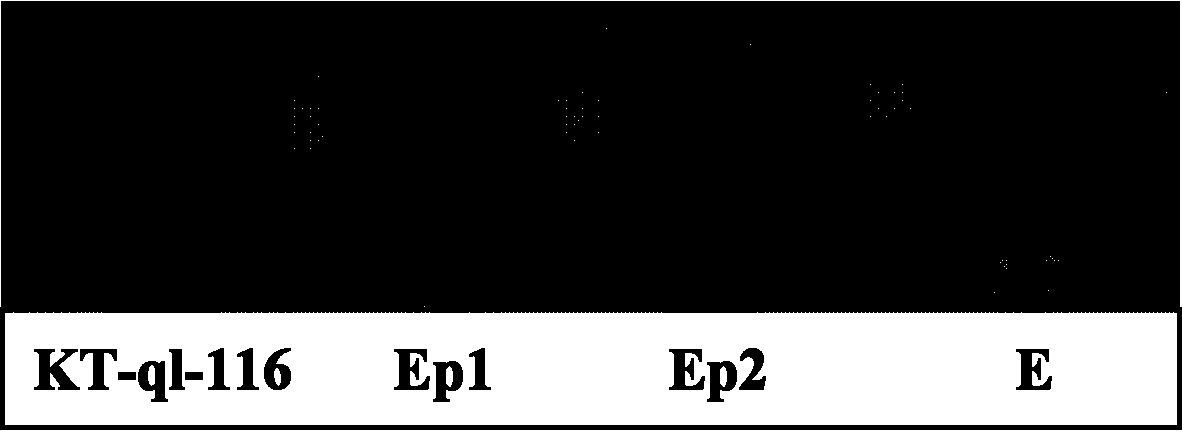Gene and its application in treatment of quinoline contaminant
A technology of gene and quinoline, which is applied in the application field of gene in the treatment of quinoline pollutants, can solve the problems that the research on quinoline's degradation characteristics and degradation methods is still in the theoretical stage, it is difficult to microbes, and it is difficult to complete.
- Summary
- Abstract
- Description
- Claims
- Application Information
AI Technical Summary
Problems solved by technology
Method used
Image
Examples
Embodiment 1
[0022] Embodiment 1, the acquisition of homoquinoline degradation gene purE1
[0023] 1. Establishment of a mutant library of the degrading bacteria Pseudomonas putida KT-ql-116 Tn5:
[0024] Pseudomonas putida KT-ql-116, which the inventor obtained from the activated sludge of Beijing Xiaojiahe Sewage Treatment Plant through primary screening and re-screening, etc., has high degradation activity to quinoline, and uses Tn5 transposition compound The homoquinoline degrading gene purE1 was cloned by constructing bacterial transposition mutant library using in vivo technology. Tn5 Transposome was EZ::TN purchased from Epicentre Tnp Transposome Kit.
[0025] 1. Preparation of degrading bacteria Pseudomonas putida KT-ql-116 electroporation competent
[0026] Pick a single colony of KT-ql-116 and inoculate it into 20ml LB, culture overnight. Inoculate 5ml of culture solution into 250mlL, shake at 210rpm, 30oC. Stop shaking the bacteria when the OD600 of the bacterial soluti...
Embodiment 2
[0042] Embodiment 2, pBBR1MCS-purE1 makes mutant strain E have high quinoline degradation activity
[0043] 1. Construction of pBBR1MCS-purE1 vector
[0044] The cloned purE1 was connected to the T-easy Blunt carrier. After the sequence was correct, it was digested with HindIII and XbaI, electrophoresed on 1% agarose gel, and the purE1 fragment was recovered for use. The broad host plasmid pBBR1MCS-5 was digested with HindIII and XbaI, and then electrophoresed on 1% agarose gel to recover the pBBR1MCS-5 vector fragment. Take 8 μl of purE1 fragment and 1 μl of treated pBBR1MCS-5, add 0.5 μl of ligase, 1 μl of buffer, and ligate overnight at 16oC. The ligation product was transformed into E.coli, colony PCR was used to detect single clones, and the correct clones were selected for sequencing, and the clones with correct sequencing were selected to obtain pBBR1MCS-purE1.
[0045] 2. pBBR1MCS-purE1 transformed mutant strain E
[0046] Mutant strain E is a Pseudomonas ...
Embodiment 3
[0050] Embodiment 3, Ep2 are to the biodegradation experiment of quinoline
[0051] We further studied the biodegradation experiment of quinoline in Ep2. The Ep2 strain was inoculated in MM2 liquid medium containing different concentrations of quinoline, the concentrations of quinoline were 500 mg / L, 650 mg / L, 700 mg / L, 750 mg / L, 800 mg / L, 850 mg / L, respectively. L, 900mg / L, 25°C, 200rpm, shaking culture. As a result, it was found that, except in the case of 900mg / L, the bacterium did not grow, and the other culture media to be tested all proliferated to varying degrees. The bacteria grew for 40.5h, 64h, 124h, 142h, At 153h and 166h, the OD600 of the bacterial solution could reach 0.7~0.8, and the quinoline in these mediums was completely degraded. The above results show that Ep2 bacteria can grow with quinoline as the only carbon source, nitrogen source and energy source, and can well tolerate and degrade quinoline at a concentration of up to 850mg / L, and can prolifera...
PUM
 Login to View More
Login to View More Abstract
Description
Claims
Application Information
 Login to View More
Login to View More - R&D
- Intellectual Property
- Life Sciences
- Materials
- Tech Scout
- Unparalleled Data Quality
- Higher Quality Content
- 60% Fewer Hallucinations
Browse by: Latest US Patents, China's latest patents, Technical Efficacy Thesaurus, Application Domain, Technology Topic, Popular Technical Reports.
© 2025 PatSnap. All rights reserved.Legal|Privacy policy|Modern Slavery Act Transparency Statement|Sitemap|About US| Contact US: help@patsnap.com

